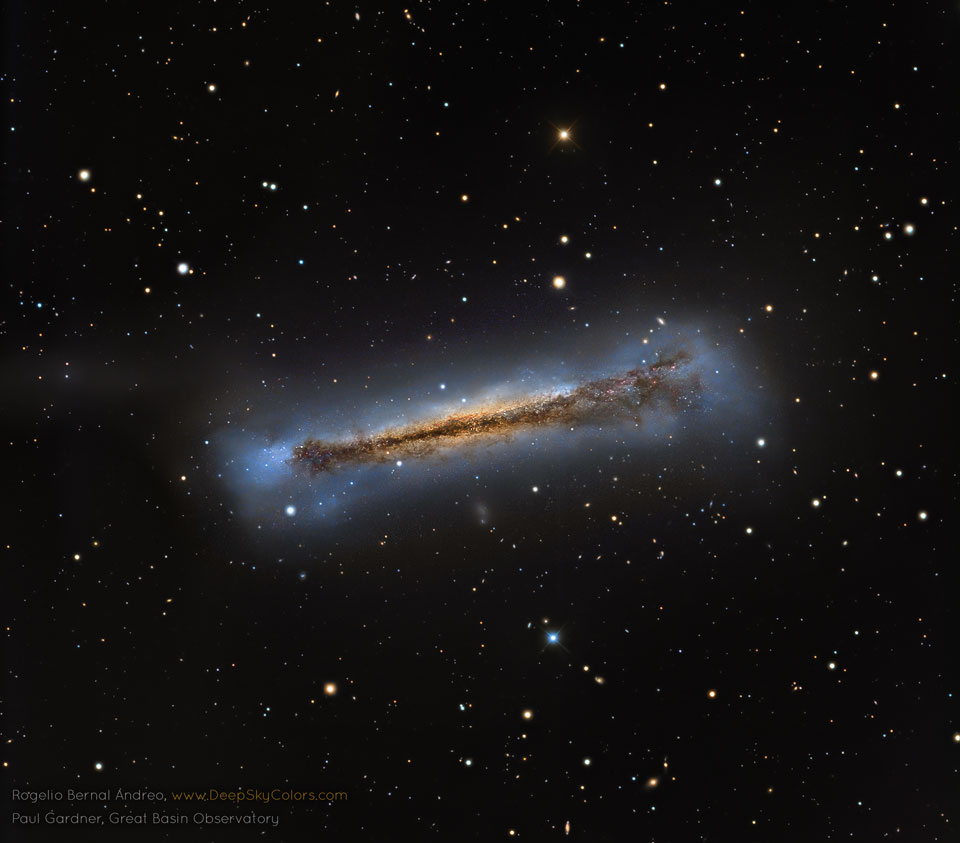
|
| Title: Astronomy Picture of the Day | |
| friendsoffortiesfive > General > General Discussion | Go to subcategory: |
| Author | Content |
|
Niceguy2
|
|
|
Date Posted:03/06/2014 11:29 PMCopy HTML I really love this site and |
|
|
Niceguy2
|
#6026 |
|
Re:Astronomy Picture of the Day Date Posted:07/29/2025 1:51 AMCopy HTML Image Credit & Copyright: Data: Paul Gardner, Great Basin Observatory; Processing: Rogelio Bernal Andreo (DeepSkyColors.com) Explanation: What do spiral galaxies look like sideways? Featured is a sharp telescopic view of a magnificent edge-on spiral galaxy NGC 3628, a puffy galactic disk divided by dark dust lanes. Of course, this deep galactic portrait puts some astronomers in mind of its popular moniker, The Hamburger Galaxy. The tantalizing island universe is about 100,000 light-years across and 35 million light-years away in the northern springtime constellation Leo. NGC 3628 shares its neighborhood in the local Universe with two other large spirals M65 and M66 in a grouping otherwise known as the Leo Triplet. Gravitational interactions with its cosmic neighbors are likely responsible for the extended flare and warp of this spiral's disk. |
|
|
Niceguy2
|
#6027 |
|
Re:Astronomy Picture of the Day Date Posted:07/30/2025 2:25 AMCopy HTML Image Credit & Copyright: George Chatzifrantzis Explanation: Is the Helix Nebula looking at you? No, not in any biological sense, but it does look quite like an eye. The Helix Nebula is so named because it also appears that you are looking down the axis of a helix. In actuality, it is now understood to have a surprisingly complex geometry, including radial filaments and extended outer loops. The Helix Nebula (aka NGC 7293) is one of brightest and closest examples of a planetary nebula, a gas cloud created at the end of the life of a Sun-like star. The remnant central stellar core, destined to become a white dwarf star, glows in light so energetic it causes the previously expelled gas to fluoresce. The featured picture, taken in red, green, and blue but highlighted by light emitted primarily by hydrogen was created from 12 hours of exposure through a personal telescope located in Greece. A close-up of the inner edge of the Helix Nebula shows complex gas knots the origin of which are still being researched. |
|
|
Niceguy2
|
#6028 |
|
Re:Astronomy Picture of the Day Date Posted:07/31/2025 2:21 AMCopy HTML Image Credit & Copyright: Andrea Vanoni Explanation: Our Sun frequently erupts in loops. Hot solar plasma jumps off the Sun's surface into prominences, with the most common type of prominence being a simple loop. The loop shape originates from the Sun's magnetic field, which is traced by spiraling electrons and protons. Many loops into the Sun's lower corona are large enough to envelop the Earth and are stable enough to last days. They commonly occur near active regions that also include dark sunspots. The featured panel shows four loops, each of which was captured near the Sun's edge during 2024 and 2025. The images were taken by a personal telescope in Mantova, Italy and in a very specific color of light emitted primarily by hydrogen. Some solar prominences suddenly break open and eject particles into the Solar System, setting up a space weather sequence that can affect the skies and wires of Earth. |
|
|
Niceguy2
|
#6029 |
|
Re:Astronomy Picture of the Day Date Posted:08/01/2025 2:08 AMCopy HTML Image Credit: Ben Godson (University of Warwick) Explanation: A long time ago in a galaxy 50 million light-years away, a star exploded. Light from that supernova was first detected by telescopes on planet Earth on July 14th though, and the extragalactic transient is now known to astronomers as supernova 2025rbs. Presently the brightest supernova in planet Earth's sky, 2025rbs is a Type Ia supernova, likely caused by the thermonuclear detonation of a white dwarf star that accreted material from a companion in a binary star system. Type Ia supernovae are used as standard candles to establish the distance scale of the universe. The host galaxy of 2025rbs is NGC 7331. Itself a bright spiral galaxy in the northern constellation Pegasus, NGC 7331 is often touted as an analog to our own Milky Way. |












